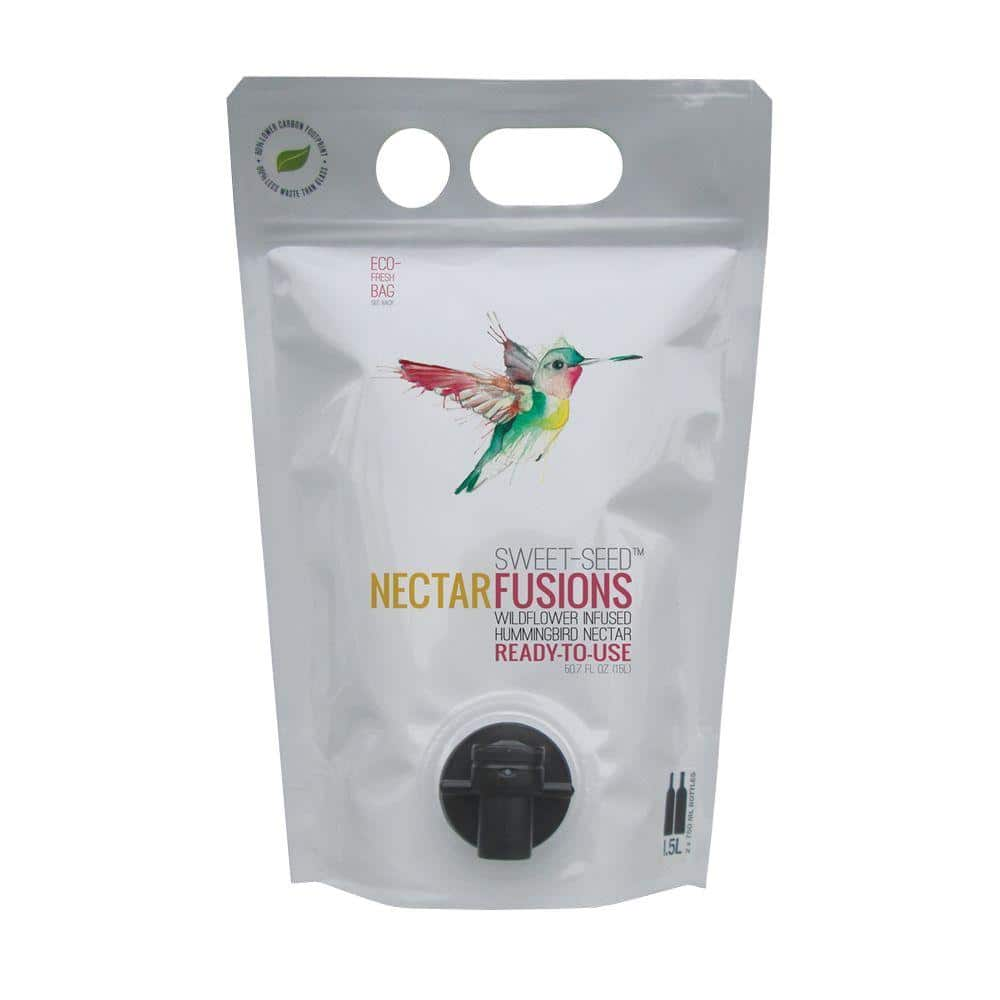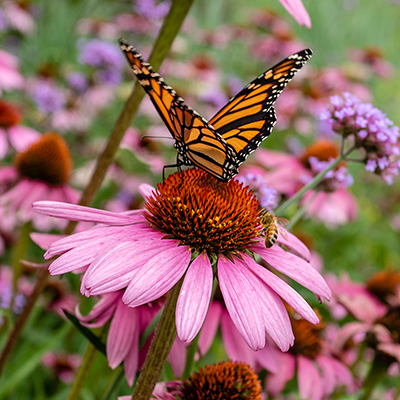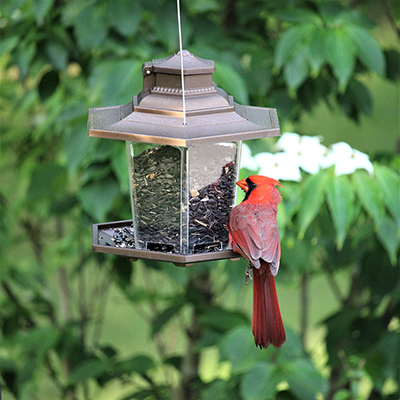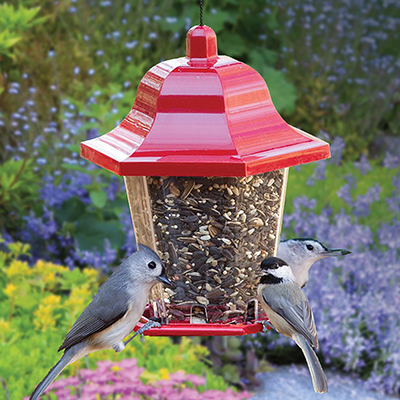Best Bird Feeders for Your Backyard

Last updated March 11, 2025
Beautiful bird feeders are designed to do more than decorate the yard. Each type of bird feeder suits different varieties of birds and their preferred food. To discover which types of bird feeders are best for you, you will need to know which bird seed each feeder accommodates, and which birds you wish to attract.
Additionally, each bird feeder differs in ease of maintenance, so choose the best bird feeder to suit your lifestyle. In this guide, learn all you need to know about the most popular types of bird feeders.
Table of Contents
How to Choose a Bird Feeder
Hopper (House) Bird Feeders
Tube Bird Feeders
Tray Bird Feeders and Platform Bird Feeders
Window Bird Feeders
Peanut Bird Feeders
How to Choose a Bird Feeder

- Bird feeders are designed to dispense certain types of bird seed, which in turn attract certain types of birds.
Before you pick the bird feeder, you should consider the birds in your area and which of those birds you want to see in your yard. From there, you can pick the types of seed those birds prefer and then the feeder that best suits the
types of seed. - Some species of birds will also prefer certain shapes and mechanisms of feeders because of their feeding habits and needs. For example, hummingbirds can only feed from nectar feeders and will not visit a hopper feeder.
- Another important consideration is how well the bird feeder will protect the bird seed from the environment and pests. It is important for bird seed to remain dry to prevent mold and mildew that can harm birds. Some bird feeders will be better than others at protecting seeds from rain. Bird feeders with squirrel guards are specially designed to prevent squirrels from stealing the bird seed.
- The frequency and ease of cleaning and refilling bird feeders are other important aspects to consider. Tray and platform bird feeders, for example, usually need to be cleaned and refilled daily.
Hopper (House) Bird Feeders

- Hopper feeders are shaped like a house, with a clear central chamber of seeds that are dispensed through openings at the feeder’s base.
- These feeders are easy for squirrels and other pests to get into, so many are now designed with mechanisms to keep out pests. Some hopper feeders will close the central chamber when anything heavier than a typical songbird steps onto the platform. These feeders may also be made of metal to deter wood-chewing pests that damage wood bird feeders.
- Hopper feeders can accommodate most seed sizes and shapres, and they hold several days' worth of seeds.
- The hopper design protects seeds from bird droppings and wind, but if the interior chamber gets wet, it can quickly promote bacteria, fungus and mold growth.
- Most feeder birds favor the hopper design.
- Best seed choice: black oil sunflower seeds.
Tube Bird Feeders

- Tube feeders are long, hollow tubes made of clear plastic or glass. They have ports with perches for small birds to feed from and may have a tray at the bottom to catch stray seeds and accommodate larger birds.
- Some tube bird feeders place the perches above the feeding ports to appeal to upside-down feeding birds like chickadees and goldfinches.
- Typically, these feeders are designed for small songbirds and can deter large birds like jays and cardinals.
- The tube protects seeds well, although some old seeds may become stuck at the bottom of the tube, below the lowest port. Always empty old seed before refilling.
- While most seed shapes and sizes will fit fine, this feeder targets smaller birds, so you should fill it with seeds that appeal to small-billed birds and easy-to-crack seeds, such as safflower.
- Best seed choice: black oil sunflower seeds or mixed seed.
Tray Bird Feeders and Platform Bird Feeders

- These feeders are simple wood, plastic or metal trays that have a mesh bottom for water to drain through. A tray feeder typically hangs while a platform feeder is liften from the ground on legs or a pole.
- Trays and platforms are not weatherproof bird feeders. The seeds in a bird feed tray are susceptible to wind, rain, pests and bird droppings. For this reason, you should clean and refill these feeders at least every other day, though daily cleaning is best.
Luckily, cleaning platform and tray bird feeders is very easy. - Large birds and ground-feeding birds prefer these feeders. A tray or platform feeder is the best bird feeder for cardinals, jays, starlings and doves.
- Best seed choices: striped sunflower seeds and safflower seeds.
Window Bird Feeders

- Window feeders are small plastic platform feeders that attach to the window with suction cups or hook to the windowsill.
- They offer close-up, intimate views of the visiting birds. They also help reduce window collisions, making them safer
for birds than placing other types of bird feeders near a window. - Window feeders should be cleaned and refilled as frequently as any other platform feeder.
- Window feeders attract finches, some sparrows, chickadees and titmice.
- Best seed choices: mixed seeds and safflower seeds.
Peanut Bird Feeders

- Peanut feeders are wire tube feeders with mesh wide enough for peanuts.
- Peanuts appeal most to woodpeckers, bluebirds and finches. Peanuts also attract squirrels, but the wire mesh of these feeders makes it difficult (though not impossible) for the squirrels to remove the nuts.
Nyjer (Thistle) Bird Feeders

- There are two types of nyjer feeders: one is a tube feeder made with very fine metal mesh, and the other is a hanging, soft mesh bag also known as a thistle "sock." Birds will cling to the mesha nd pull the fine nyjer (thistle) seeds through it.
- Thistle socks collect water, so you should empty and clean them immediately after rain. Use small nyjer feeders to avoid wasting this higher-priced seed.
- Squirrels usually will not eat nyjer, so they do not bother these feeders.
- Nyjer feeders are a favorite among goldfinches, house finches, redpolls, pine siskins and other small, clinging birds.
Ground Bird Feeders

- Ground feeders are platform feeders with legs that sit slightly above ground level to keep the seeds clean and dry.
- Like all platform feeders, ground feeders should be cleaned and refilled often.
- Ground feeders are best for birds that prefer to forage on the ground, such as juncos, doves and blackbirds. However, these feeders will also attract other critters, so it is best to use inexpensive seed like milo and cracked corn.
- Cracked corn in ground feeders can draw ducks, doves, quail and wild turkey.
- Best seed choice: mixed seed.
Suet Bird Feeders

- Suet feeders are hanging wired cages that are shaped to hold suet cakes. Most often, they are simple square cages.
- Suet is a high-protein bird food, so it naturally draws insect-eating birds.
- A suet feeder is one of the best bird feeders for winter, since it offers birds such nutrient-dense food.
- Unprocessed suet quickly becomes rancid in hot weather, so clean and refill suet feeders often or use processed, heat-proof suet.
- Woodpeckers, bluebirds, wrens, warblers and cardinals love suet feeders.
Nectar Bird Feeders (Hummingbird Feeders)

- Nectar feeders, frequently called hummingbird feeders, come in many different shapes, but always have a clear container to hold nectar and small dispenser ports.
- If the ports are large enough, these feeders will feed orioles as well as hummingbirds.
- Nectar is just sugar water. Mix and dissolve one part sugar in four parts water. Do not add food coloring to the nectar, as this may be poisonous to the birds. Additionally, do not use artificial sweeteners, honey or fruit juice in place of sugar.
- You must change the nectar every 3 to 5 days, or sooner, to avoid mold growth and fermentation, both of which can be deadly to hummingbirds.
- Nectar bird feeders may also attract bugs. Do not use an insecticide. Instead, clean the feeder more often or use an ant guard.
To attract more bird species, add a variety of bird feeders to your backyard. Appeal to birds' natural curiosity with an assortment of bird feeders and a bird bath for them to enjoy.
Use The Home Depot Mobile App to view our wide selection of bird feeders.































